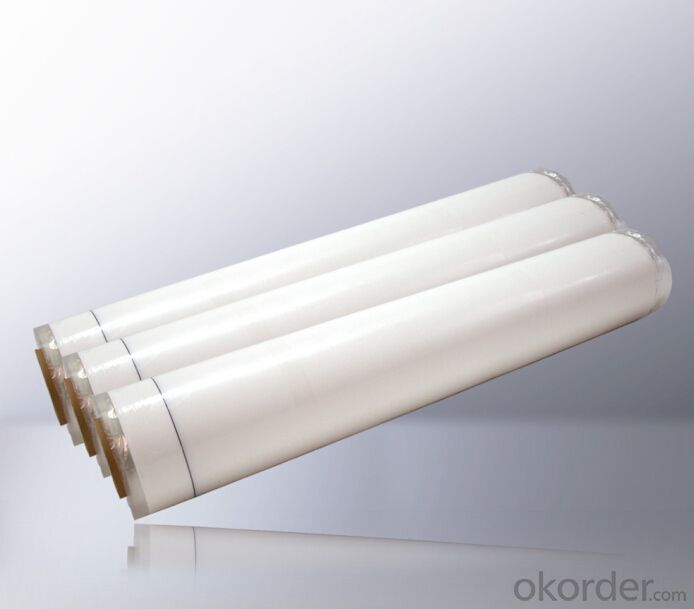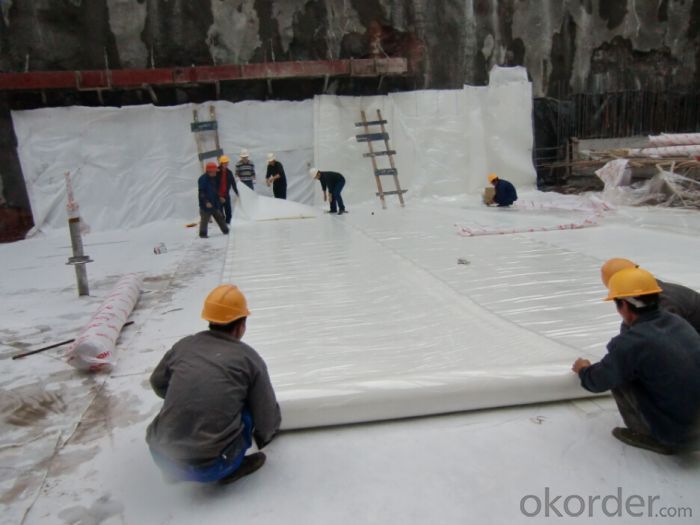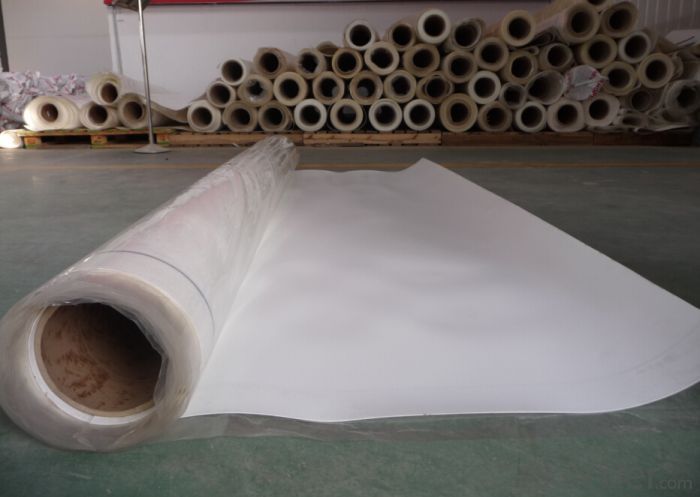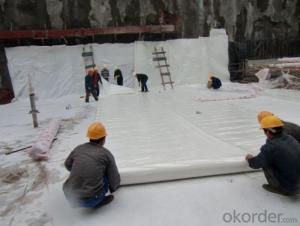HDPE Self-adhesive Waterproof Membrane 1.2mm
- Loading Port:
- China Main Port
- Payment Terms:
- TT or LC
- Min Order Qty:
- 5000 m²
- Supply Capability:
- 100000 m²/month
OKorder Service Pledge
OKorder Financial Service
You Might Also Like
HDPE Waterproof Membrane Introduction:
HDPE Self-adhesive Waterproof Membrane is specially used in underground project, it can bond with concrete layer tightly. After Membrane bonding with concrete, water can be blocked between membrane and concrete, which can improve the reliability.
HDPE Waterproof Membrane Applications:
Basement,Subway,Tunnel Cave, Other underground public constructions.
HDPE Waterproof Membrane Advantages:
1. Good bonding with concrete applied on membrane, to block water between membrane and concrete further to protect concrete effectively.
2. Low flatness requirement to substrate, reliable overlapping; mechanical fixing, easy application.
3. Sound anti-puncture performance.
4. Adaptable to settlement and distortion.
5. Weather-resisting and anti-UV.
6. Resist to acid, alkali, mold.
7. Eco-friendly material
HDPE Waterproof Membrane Specifications:
| Width(m) | Length(m) | Thickness(mm) |
| 1.2 or 2.4 | 20 or more | 1.2 or 1.5 |
FAQ:
Q: What kind of payment way your company accept?
A: TT, LC, etc
Q: Can I do the third party testing before loading?
A: Yes, we could accept the third party testing.
Q: Which kind of payment in your company?
A: We could accept TT, LC at sight, etc.





- Q:Can a waterproofing membrane be certified or approved by industry organizations?
- Indeed, industry organizations have the ability to certify or approve waterproofing membranes. There exist various industry organizations and standards bodies that assess and endorse building materials and products, including waterproofing membranes. These certifications or approvals serve as a guarantee that the membrane satisfies specific quality and performance standards established by the industry. Well-known industry organizations such as the International Organization for Standardization (ISO), Underwriters Laboratories (UL), and the American Society for Testing and Materials (ASTM) often grant certifications or approvals for waterproofing membranes. These certifications involve thorough testing and evaluation of the membrane's physical properties, such as its resistance to water penetration, durability, and compatibility with other construction materials. Certifications or approvals from industry organizations provide reassurance to consumers, architects, contractors, and building owners regarding the waterproofing membrane's thorough testing and alignment with recognized standards for quality and performance. They also facilitate compliance with building codes and may be obligatory for specific projects. It is always prudent to seek out waterproofing membranes that have received certification or approval from reputable industry organizations to ensure that you are utilizing a dependable and efficient product for your waterproofing requirements.
- Q:Can a waterproofing membrane be used on glass block surfaces?
- Yes, a waterproofing membrane can be used on glass block surfaces. Glass block surfaces are often used in areas such as bathrooms or kitchens where waterproofing is essential to prevent water damage. Applying a waterproofing membrane helps to create a barrier that prevents water from penetrating the glass blocks, protecting the underlying structures and materials. The membrane is typically applied to the exterior side of the glass block surface, ensuring that any water that comes into contact with the surface is directed away and does not seep through. It is important to choose a waterproofing membrane that is specifically designed for use on glass block surfaces to ensure proper adhesion and long-lasting protection.
- Q:Can waterproofing membranes be used on elevator shafts?
- Yes, waterproofing membranes can be used on elevator shafts to prevent water infiltration and protect the structure from moisture damage.
- Q:Can a waterproofing membrane be used on brick walls?
- Brick walls, being porous, can absorb water and moisture, leading to damage and deterioration. To combat this, a waterproofing membrane can be applied. This membrane acts as a barrier, preventing water from entering the bricks while still allowing moisture to evaporate. By keeping the bricks dry, it reduces the risk of issues like efflorescence, mold, and mildew. Additionally, it improves the thermal insulation of the walls, reducing heat loss and enhancing energy efficiency. It is crucial to select a waterproofing membrane specifically made for masonry surfaces to ensure proper adhesion and long-lasting protection.
- Q:Can a waterproofing membrane be used for elevator shafts or equipment rooms?
- Yes, a waterproofing membrane can be used for elevator shafts or equipment rooms to prevent water infiltration and protect the structural integrity of the building.
- Q:Can a waterproofing membrane be used on stone surfaces?
- Yes, a waterproofing membrane can be used on stone surfaces. Stone surfaces, such as natural or manufactured stone, can benefit from the application of a waterproofing membrane to prevent water penetration and protect against moisture-related issues. Waterproofing membranes are designed to create a barrier against water and other liquids, preventing them from seeping into the stone and causing damage. This can be particularly important for exterior stone surfaces that are exposed to rain, snow, and other weather conditions. Additionally, using a waterproofing membrane on stone surfaces can help prolong the lifespan of the stone by reducing the risk of cracks, spalling, and other forms of deterioration caused by water absorption. It is essential to choose a waterproofing membrane specifically formulated for stone surfaces to ensure proper adhesion and long-lasting protection.
- Q:Can a waterproofing membrane be used for data centers?
- Using a waterproofing membrane in data centers is possible. The main purpose of a waterproofing membrane is to stop water from getting in, which is very important for safeguarding delicate equipment and crucial data in a data center. Water damage can lead to expensive periods of inactivity and data loss, so it is crucial to have dependable waterproofing measures in place. By applying a waterproofing membrane to the walls, floors, and ceilings of a data center, a barrier can be created to prevent water leaks and the buildup of moisture. This ensures that a controlled and dry environment is maintained, guaranteeing the safety and functionality of the data center's infrastructure and equipment. Furthermore, certain waterproofing membranes also provide insulation properties, further improving the protection and energy efficiency of the data center.
- Q:How does a waterproofing membrane ensure a watertight seal around penetrations?
- A waterproofing membrane ensures a watertight seal around penetrations by providing a protective barrier that prevents water from seeping through gaps or openings. It is designed to adhere tightly to the surface, creating a seamless and impermeable layer that seals off any potential entry points for water. This membrane acts as a shield, effectively preventing moisture from penetrating the structure and causing damage or leakage.
- Q:Does a waterproofing membrane require any maintenance or regular inspections?
- Yes, a waterproofing membrane does require maintenance and regular inspections. While waterproofing membranes are designed to be durable and long-lasting, they are not immune to wear and tear or potential damages. Regular inspections are essential to identify any signs of damage or deterioration, which can then be addressed promptly to prevent further issues. Maintenance activities may include cleaning the membrane to remove dirt or debris, repairing any visible cracks or tears, and ensuring proper drainage and water flow. Additionally, it is advisable to follow the manufacturer's guidelines for maintenance and schedule professional inspections periodically to ensure the effectiveness and longevity of the waterproofing membrane.
- Q:How does a waterproofing membrane adhere to a surface?
- The adherence of a waterproofing membrane to a surface is achieved through a combination of mechanical and chemical bonding mechanisms. To establish a strong and enduring connection between the membrane and the surface, an adhesive or bonding agent is typically applied. Mechanical bonding occurs when the membrane is secured in place by the irregularities and imperfections on the surface. This can be further reinforced with the use of mechanical fasteners like screws or nails, which help to firmly hold the membrane. These initial mechanical bonds provide stability and prevent any shifting or peeling of the membrane. On the other hand, chemical bonding involves the utilization of adhesives specifically designed for waterproofing purposes. These adhesives are applied both to the surface and the backside of the membrane. Once the membrane is pressed onto the surface, a chemical reaction takes place between the adhesive, the surface, and the membrane, resulting in a robust bond. The efficiency of the adhesive is influenced by various factors including surface preparation, environmental conditions, and the specific type of membrane and adhesive used. Proper surface preparation, which may include cleaning, priming, or leveling, is essential to ensure that there are no contaminants or unevenness that could compromise the bond. In conclusion, the adhesion of a waterproofing membrane to a surface is achieved through a combination of mechanical and chemical bonding mechanisms. Mechanical bonds provide initial stability, while adhesive materials create a durable and long-lasting connection between the membrane and the surface.
1. Manufacturer Overview |
|
|---|---|
| Location | |
| Year Established | |
| Annual Output Value | |
| Main Markets | |
| Company Certifications | |
2. Manufacturer Certificates |
|
|---|---|
| a) Certification Name | |
| Range | |
| Reference | |
| Validity Period | |
3. Manufacturer Capability |
|
|---|---|
| a)Trade Capacity | |
| Nearest Port | |
| Export Percentage | |
| No.of Employees in Trade Department | |
| Language Spoken: | |
| b)Factory Information | |
| Factory Size: | |
| No. of Production Lines | |
| Contract Manufacturing | |
| Product Price Range | |
Send your message to us
HDPE Self-adhesive Waterproof Membrane 1.2mm
- Loading Port:
- China Main Port
- Payment Terms:
- TT or LC
- Min Order Qty:
- 5000 m²
- Supply Capability:
- 100000 m²/month
OKorder Service Pledge
OKorder Financial Service
Similar products
New products
Hot products
Hot Searches
Related keywords





























